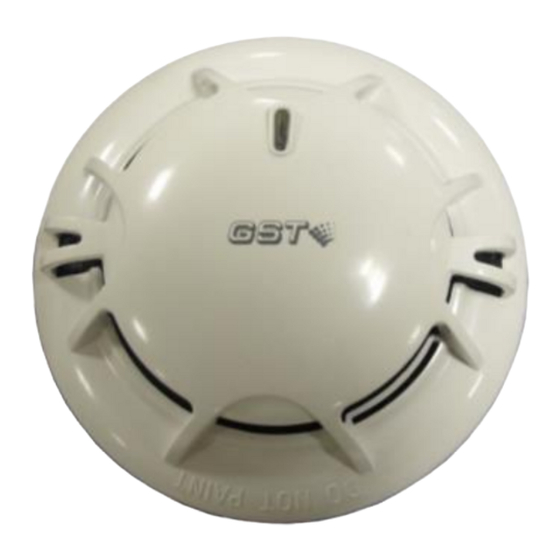Advertisement
Quick Links
Features
Reed switch testing.
Remote indicator output available.
2 levels smoke sensitivities programmable, complies with
UL268. Heat part is fixed temperature, complies with UL521.
Description
DC-M9101 Conventional Combination Heat Photoelectric Smoke
Detector integrates photoelectric detection and fixed temperature
detection
technology
by
combining
semi-conductor heat sensor in mechanism and circuitry structure.
Just because of the combination of smoke detection and heat
detection, it not only overcomes the disadvantage that detectors
using common infrared scattering technology are insensitive to
black smoke with small particles, but also can pick up fire with
obvious rise of temperature such as alcohol flame, thus extending
its application range.
On detecting a fire signal, it can change its own current to transmit
the signal to fire alarm control panel (FACP) or addressable zone
monitor unit. The detector keeps illuminating fire LED until it is reset
by power-down.
Connection and Cabling
The detector connects with UL-certified products such as I-M9300
module and intelligent control panels. The detector bottom is shown
in Fig. 1 and the base in Fig. 2.
Fig. 1
Please install the base according to following steps:
1)
Locate mounting holes on the rubber layer of the base
according to the holes on the back box, and punch the holes
with a screwdriver.
2)
Count the number of cables needed and punch correct
quantity of holes with a screwdriver on the rubber layer.
Thread the cables through the cable entry holes.
3)
Install the base onto the back box with screws.
Warning: Do not punch mounting holes and cable entry holes
bigger than needed. Do not punch more holes than needed.
There are four terminals with numbers on the base.
1: Detection zone positive IN
2: Detection zone positive OUT
3: Detection zone negative IN and OUT
2: Positive terminal of remote indicator
4: Negative terminal of remote indicator
It connects a 4.7k/1w resistor between number 2 and 3 at the end
of the base. The system connection is shown in Fig. 3.
O +
O -
Remote Indicator
Conventional Detector
Recommended Cabling
2
1.0mm
or above fire cable is recommended, laid through metal or
flame-retardant conduit, but subject to local codes. Different color
cables for remote indicator are used to avoid wiring mistake.
I-M9300 modules connect with 15 conventional devices at most.
Note: It's recommended to use cables of different colors to
avoid incorrect wiring.
30309581
smoke
sensor
and
Mounting
Cable Entry
Hole
Fig. 2
Remote Indicator
Conventional Detector
Fig. 3
DC-M9101 Conventional Combination
Heat Photoelectric Smoke Detector
Installation
Refer to D Series Detector Application Bulletin for additional
installation instructions.
A fixed installation direction is ensured by the location elements on
the detector and the base. Fix the base with two tapping screws,
and then align mark A on the detector with B on the base, rotate the
detector to align mark A with mark C (Refer to Fig. 1 and 2 for the
position of the marks), the detector will be fitted to the base.
Fig. 4 shows the installation of the detector.
54.5mm
Application
Warning: The alarm current depends on the current
limit of the control panel. 24VDC cannot power the
detector directly. Otherwise the detector will be
blown up for lack of current limit resistor.
Fixed temperature and level 2 are default. Sensitivity level of the
detector can be set, read or written in field by using P-9910B
programmer.
In power-on state, input unlocking password and press Clear to
unlock. Press Function, then press "3", the screen shows "_" at the
last digit.
Input corresponding sensitivity or parameter and press Program, the
screen will show a "P", the corresponding sensitivity or parameter is
programmed. Press Clear to clear the "P". Input locking password
and press Clear to return.
Parameters set using programmer
Input Parameter
of a Detector
1
2
Read Sensitivity Level: in power-on state, pressing Test, the screen
displays address of the detector. Pressing "Up", display sensitivity
level, device type and initial sensitivity in turns.
Testing
Before testing, please ensure that the detector has been
installed correctly and powered up. After 10 seconds, testing
begins.
Before testing, notify the proper authorities that the system is under
maintenance and will temporarily be out of service. Disable the
automatic controls relating to the zone or system under
maintenance to avoid unwanted actions.
All detectors must be tested after installation and periodically
thereafter. Testing methods must satisfy the Authority Having
Jurisdiction (AHJ). Detectors offer maximum performance when
tested and maintained in compliance with NFPA 72. The detector
can be tested in the following way:
Electrical Box
Conduit
Base
Detector
Fig. 4
Smoke
Heat Part
Sensitivity
1
Fixed
2
Fixed
Issue 1.08
Advertisement

Summary of Contents for GST DC-M9101
- Page 1 Remote indicator output available. 2 levels smoke sensitivities programmable, complies with UL268. Heat part is fixed temperature, complies with UL521. Description DC-M9101 Conventional Combination Heat Photoelectric Smoke Detector integrates photoelectric detection and fixed temperature detection technology combining smoke sensor semi-conductor heat sensor in mechanism and circuitry structure.
-
Page 2: Limited Warranty
5. The detector cannot monitor the place beyond protection area. distributor for products not covered by this warranty. This document is subject to change without notice. Please contact GST for more information or questions. Gulf Security Technology Co., Ltd. No. 80, Changjiang East Road, QETDZ, Qinhuangdao, Hebei, P. R. China 066004 Tel: +86 (0) 335 8502434 Fax: +86 (0) 335 8502532 service.gst@fs.utc.com...















Need help?
Do you have a question about the DC-M9101 and is the answer not in the manual?
Questions and answers